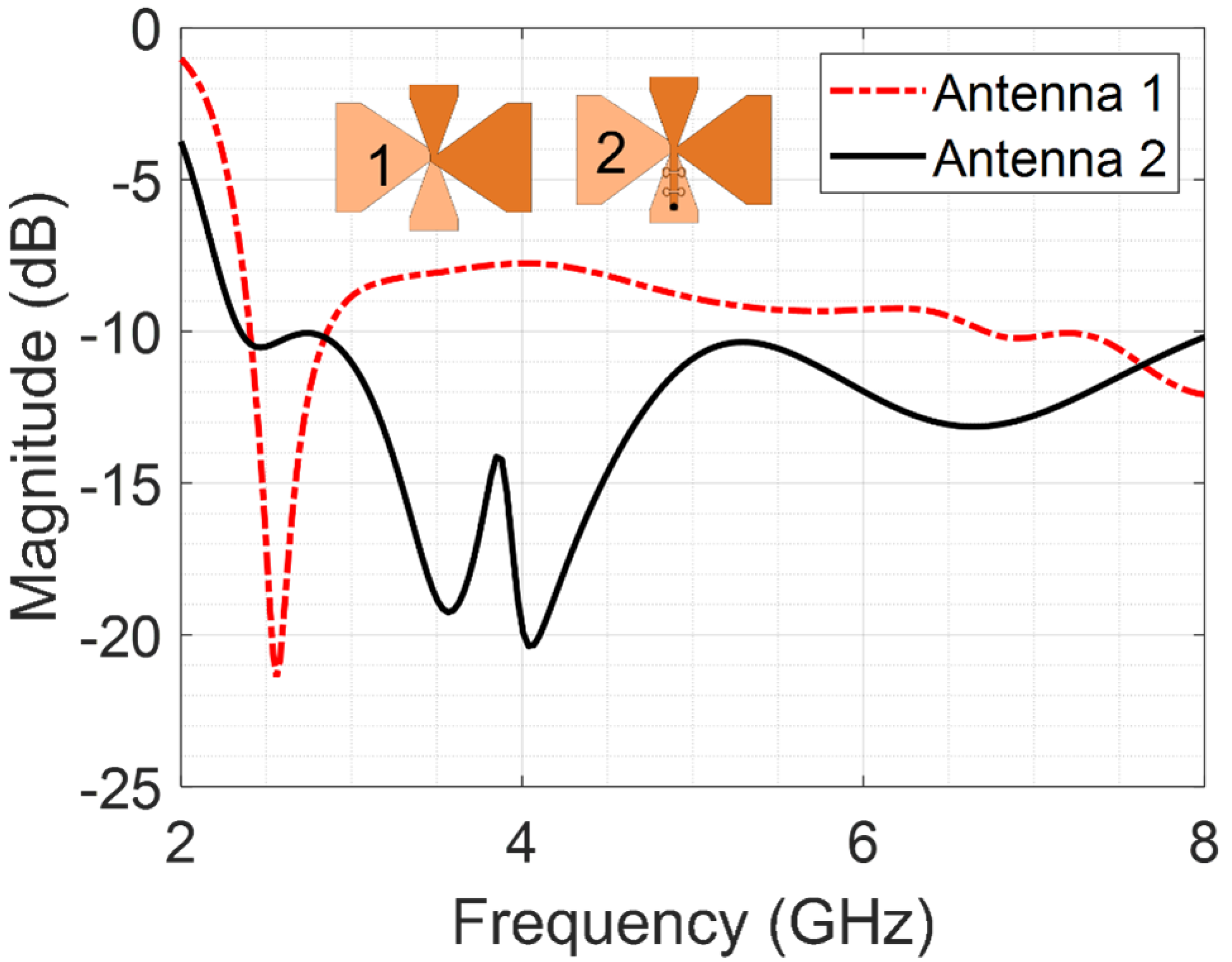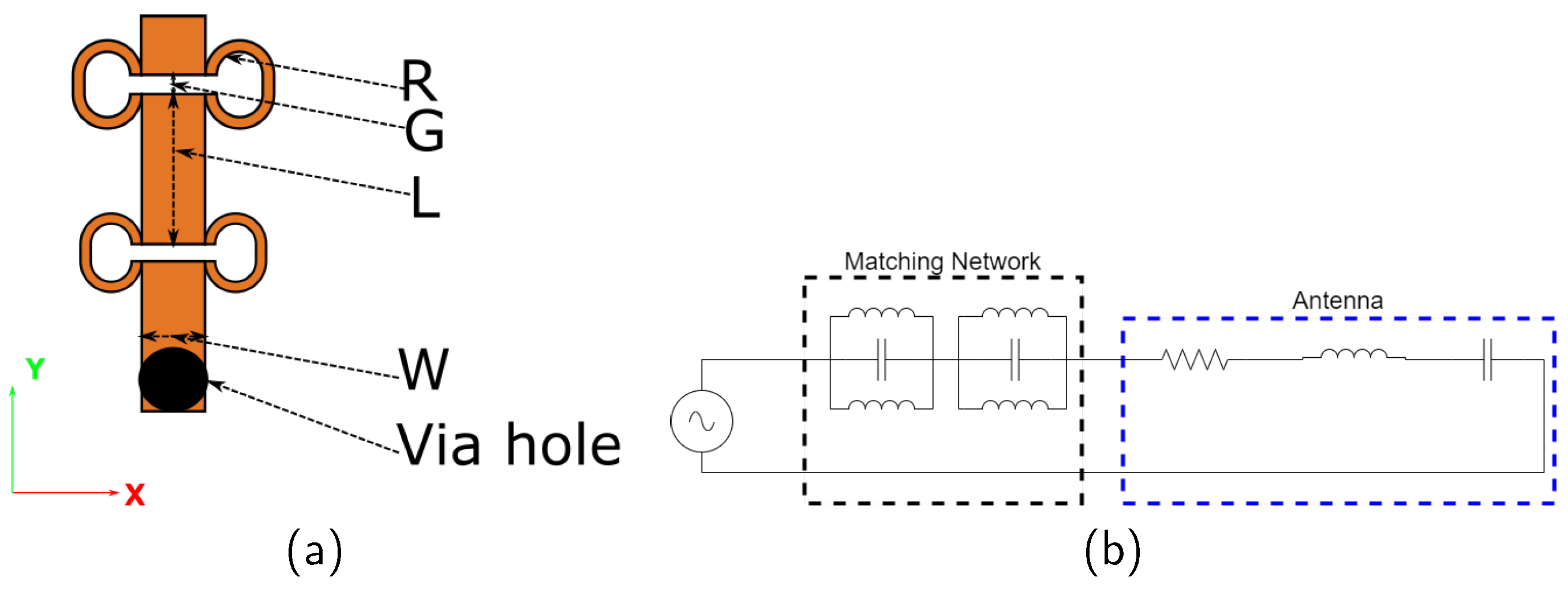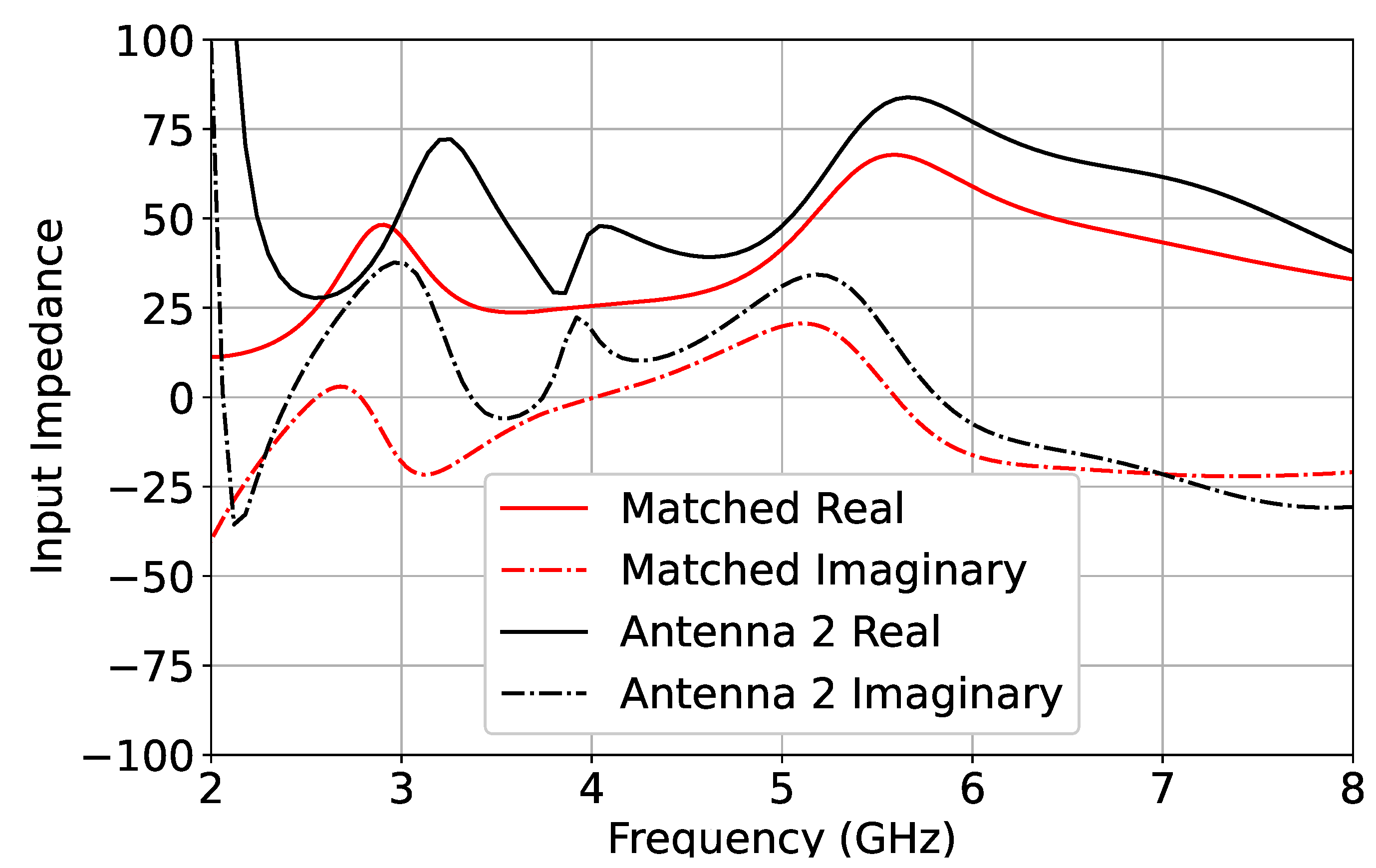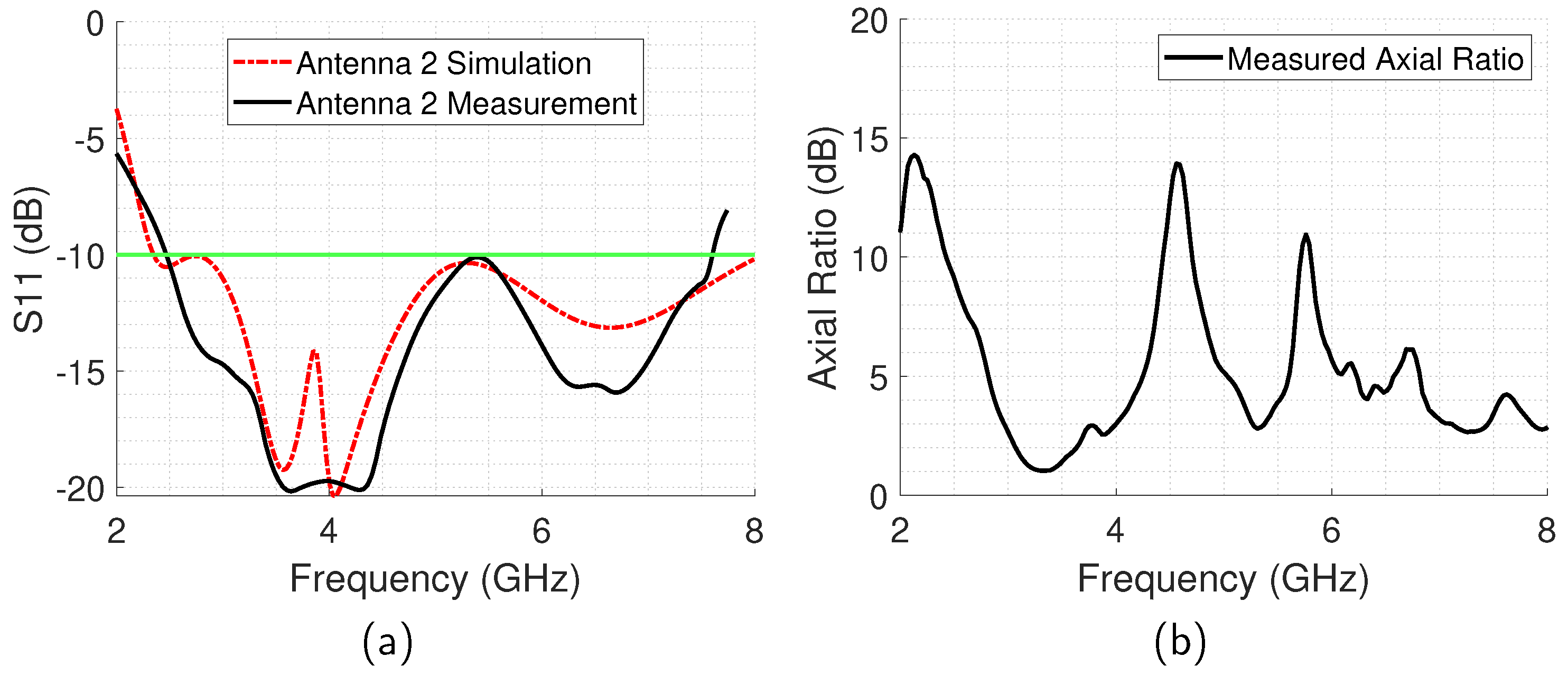Design and Implementation of a Printed Circuit Model for a Wideband Circularly Polarized Bow-Tie Antenna
Abstract
:1. Introduction
- A design for a circularly polarized, wideband 2.44–7.62 GHz S- and C-Band antenna that does not require hybrid couplers or multiple feeds;
- Analytical solutions to the input admittance of the antenna that can be used to adapt the design without time-consuming full-wave simulations and optimization;
- An integrated matching network design to improve the bandwidth of the antenna;
- An equivalent circuit model of the proposed matching network that can expedite the design of similar matching networks prior to full-wave simulation.
2. Materials and Methods
2.1. Polarization Mechanism
2.2. Optimization
3. Results and Discussion
4. Conclusions
Author Contributions
Funding
Data Availability Statement
Conflicts of Interest
References
- Theoharis, P.I.; Raad, R.; Tubbal, F.; Ali Khan, M.U.; Liu, S. Software-Defined Radios for CubeSat Applications: A Brief Review and Methodology. IEEE J. Miniaturization Air Space Syst. 2021, 2, 10–16. [Google Scholar] [CrossRef]
- Devaraj, K.; Ligon, M.; Blossom, E.; Breu, J.; Klofas, B.; Colton, K.; Kingsbury, R.; Street, H.; Francisco, S. Planet High Speed Radio: Crossing Gbps from a 3U Cubesat. In Proceedings of the 2019 Small Satellite Conference, Logan, UT, USA, 3–8 August 2019; p. 10. [Google Scholar]
- Kaneko, T.; Kawano, N.; Nagao, Y.; Murakami, K.; Watanabe, H.; Mita, M.; Tomoda, T.; Hirako, K.; Shirasaka, S.; Nakasuka, S.; et al. 2.65Gbps Downlink Communications with Polarization Multiplexing in x-Band for Small Earth Observation Satellite. IEICE Trans. Commun. 2021, E104.B, 1–12. [Google Scholar] [CrossRef]
- Ellison, S.M.; Nanzer, J.A. High-Accuracy Multinode Ranging For Coherent Distributed Antenna Arrays. IEEE Trans. Aerosp. Electron. Syst. 2020, 56, 4056–4066. [Google Scholar] [CrossRef]
- Peral, E.; Im, E.; Wye, L.; Lee, S.; Tanelli, S.; Rahmat-Samii, Y.; Horst, S.; Hoffman, J.; Yun, S.H.; Imken, T.; et al. Radar Technologies for Earth Remote Sensing From CubeSat Platforms. Proc. IEEE 2018, 106, 404–418. [Google Scholar] [CrossRef]
- Rahmat-Samii, Y.; Manohar, V.; Kovitz, J.M. For Satellites, Think Small, Dream Big: A Review of Recent Antenna Developments for CubeSats. IEEE Antennas Propag. Mag. 2017, 59, 22–30. [Google Scholar] [CrossRef]
- Gao, S.; Clark, K.; Unwin, M.; Zackrisson, J.; Shiroma, W.A.; Akagi, J.M.; Maynard, K.; Garner, P.; Boccia, L.; Amendola, G.; et al. Antennas for Modern Small Satellites. IEEE Antennas Propag. Mag. 2009, 51, 40–56. [Google Scholar] [CrossRef]
- Dyson, J. The Equiangular Spiral Antenna. IRE Trans. Antennas Propag. 1959, 7, 181–187. [Google Scholar] [CrossRef]
- Volakis, J.; Nurnberger, M.; Filipovic, D. Slot Spiral Antenna. IEEE Antennas Propag. Mag. 2001, 43, 15–26. [Google Scholar] [CrossRef]
- Manohar, V.; Bhardwaj, S.; Venkatakrishnan, S.B.; Volakis, J.L. VHF/UHF Ultrawideband Tightly Coupled Dipole Array for CubeSats. IEEE Open J. Antennas Propag. 2021, 2, 702–708. [Google Scholar] [CrossRef]
- Wheeler, H. Simple Relations Derived Fom a Phased-Array Antenna Made of an Infinite Current Sheet. IEEE Trans. Antennas Propag. 1965, 13, 506–514. [Google Scholar] [CrossRef]
- Doane, J.P.; Sertel, K.; Volakis, J.L. A Wideband, Wide Scanning Tightly Coupled Dipole Array with Integrated Balun (TCDA-IB). IEEE Trans. Antennas Propag. 2013, 61, 4538–4548. [Google Scholar] [CrossRef]
- Jordan, J.W.; Stacy, W.; Ng, J.; Cannon, B.L.; Caba, A.; Vanhille, K.J.; Clough, J.; Stant, B.; Racette, P.E. PolyStrata® X/Ku/K/Ka-band, Dual-Polarized, Tightly Coupled Dipole Scannable Focal Plane Array. In Proceedings of the 2018 IEEE International Symposium on Antennas and Propagation USNC/URSI National Radio Science Meeting, Boston, MA, USA, 8–13 July 2018; pp. 817–818. [Google Scholar] [CrossRef]
- Eldek, A.; Elsherbeni, A.; Smith, C. Wide-Band Modified Printed Bow-Tie Antenna with Single and Dual Polarization for C - and X-band Applications. IEEE Trans. Antennas Propag. 2005, 53, 3067–3072. [Google Scholar] [CrossRef]
- Alibakhshikenari, M.; Virdee, B.S.; See, C.H.; Shukla, P.; Mansouri Moghaddam, S.; Zaman, A.U.; Shafqaat, S.; Akinsolu, M.O.; Liu, B.; Yang, J.; et al. Dual-Polarized Highly Folded Bowtie Antenna with Slotted Self-Grounded Structure for Sub-6 GHz 5G Applications. IEEE Trans. Antennas Propag. 2022, 70, 3028–3033. [Google Scholar] [CrossRef]
- Feng, G.; Chen, L.; Wang, X.; Xue, X.; Shi, X. Broadband Circularly Polarized Crossed Bowtie Dipole Antenna Loaded With Parasitic Elements. IEEE Antennas Wirel. Propag. Lett. 2018, 17, 114–117. [Google Scholar] [CrossRef]
- Fiser, O.; Hruby, V.; Vrba, J.; Drizdal, T.; Tesarik, J.; Vrba, J., Jr.; Vrba, D. UWB Bowtie Antenna for Medical Microwave Imaging Applications. IEEE Trans. Antennas Propag. 2022, 70, 5357–5372. [Google Scholar] [CrossRef]
- Jeong, J.; Park, K.; Lee, C. Design of Cavity-Backed Bow-Tie Antenna with Matching Layer for Human Body Application. Sensors 2019, 19, 4015. [Google Scholar] [CrossRef] [PubMed]
- Pi, S.; Wang, T.; Lin, J. Directional and High-Gain Ultra-Wideband Bow-Tie Antenna for Ground-Penetrating Radar Applications. Remote Sens. 2023, 15, 3522. [Google Scholar] [CrossRef]
- Yang, G.; Ye, S.; Ji, Y.; Zhang, X.; Fang, G. Radiation Enhancement of an Ultrawideband Unidirectional Folded Bowtie Antenna for GPR Applications. IEEE Access 2020, 8, 182218–182228. [Google Scholar] [CrossRef]
- Dodd, M.J.; Elsherbeni, A.Z. A Wideband Circularly Polarized Printed Bow-Tie Antenna for Low-SWaP Aerial Applications. In Proceedings of the 2022 IEEE 20th Biennial Conference on Electromagnetic Field Computation (CEFC), Virtual, 24–26 October 2022; pp. 1–2. [Google Scholar] [CrossRef]
- Dodd, M.J.; Elsherbeni, A.Z. Bowtie Antenna with Integrated Matching Network for Wideband and Circular Polarization. In Proceedings of the 2023 IEEE International Symposium on Antennas and Propagation and USNC-URSI Radio Science Meeting (USNC-URSI), Portland, OR, USA, 23–28 July 2023; pp. 1531–1532. [Google Scholar] [CrossRef]
- Schelkunoff, S. Electromagnetic Waves; Bell Telephone Company Series; Van Nostrand: New York, NY, USA, 1943. [Google Scholar]
- Balanis, C.A. Antenna Theory: Analysis and Design; Wiley: Hoboken, NJ, USA, 2005. [Google Scholar]
- Papas, C.; King, R. Input Impedance of Wide-Angle Conical Antennas Fed by a Coaxial Line. Proc. IRE 1949, 37, 1269–1271. [Google Scholar] [CrossRef]
- Compton, R. Perspectives in Microwave Circuit Analysis. In Proceedings of the 32nd Midwest Symposium on Circuits and Systems, Champaign, IL, USA, 14–16 August 1989; Volume 2, pp. 716–718. [Google Scholar] [CrossRef]
- Arsenovic, A.; Hillairet, J.; Anderson, J.; Forstén, H.; Rieß, V.; Eller, M.; Sauber, N.; Weikle, R.; Barnhart, W.; Forstmayr, F. Scikit-Rf: An Open Source Python Package for Microwave Network Creation, Analysis, and Calibration [Speaker’s Corner]. IEEE Microw. Mag. 2022, 23, 98–105. [Google Scholar] [CrossRef]
- IEEE Std 149-2021 (Revision of IEEE Std 149-1977); IEEE Recommended Practice for Antenna Measurements. IEEE: Piscataway, NJ, USA, 2022; pp. 1–207. [CrossRef]









| Ref. | Freq. Range | Impedance BW | Polarization | Peak Gain |
|---|---|---|---|---|
| This Work | 2.44–7.62 GHz | 103% | Circular, one feed | 7.29 dBi |
| [15] | 3.1–5.0 GHz | 47% | Dual, two feeds | 7.5 dBi |
| [16] | 2.21–6.06 GHz | 93% | Circular, one feed | 8.6 dBi |
| [17] | 1.0–6.0 GHz | 143% | Linear, balun feed | NA 1 |
| [18] | 2.64–3.60 GHz | 31% | Linear, balun feed | 7.4 dBi |
| [19] | 0.32–0.93 GHz | 98% | Linear, single feed | 9.3 dBi |
| [20] | 0.25–0.85 GHz | 109% | Linear, balun feed | 4 dBi |
Disclaimer/Publisher’s Note: The statements, opinions and data contained in all publications are solely those of the individual author(s) and contributor(s) and not of MDPI and/or the editor(s). MDPI and/or the editor(s) disclaim responsibility for any injury to people or property resulting from any ideas, methods, instructions or products referred to in the content. |
© 2024 by the authors. Licensee MDPI, Basel, Switzerland. This article is an open access article distributed under the terms and conditions of the Creative Commons Attribution (CC BY) license (https://creativecommons.org/licenses/by/4.0/).
Share and Cite
Dodd, M.J.; Elsherbeni, A.Z. Design and Implementation of a Printed Circuit Model for a Wideband Circularly Polarized Bow-Tie Antenna. Electronics 2024, 13, 3323. https://doi.org/10.3390/electronics13163323
Dodd MJ, Elsherbeni AZ. Design and Implementation of a Printed Circuit Model for a Wideband Circularly Polarized Bow-Tie Antenna. Electronics. 2024; 13(16):3323. https://doi.org/10.3390/electronics13163323
Chicago/Turabian StyleDodd, Matthew J., and Atef Z. Elsherbeni. 2024. "Design and Implementation of a Printed Circuit Model for a Wideband Circularly Polarized Bow-Tie Antenna" Electronics 13, no. 16: 3323. https://doi.org/10.3390/electronics13163323






